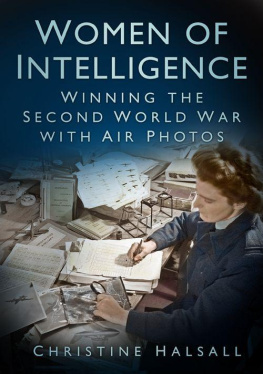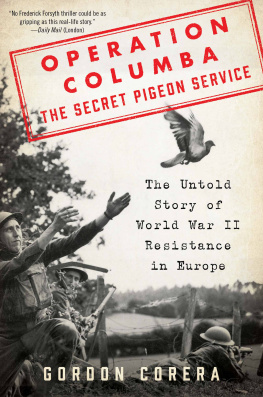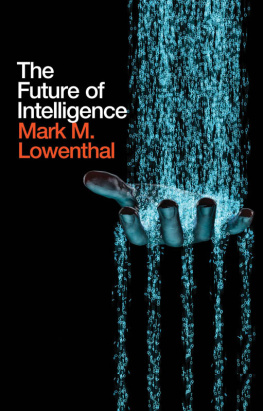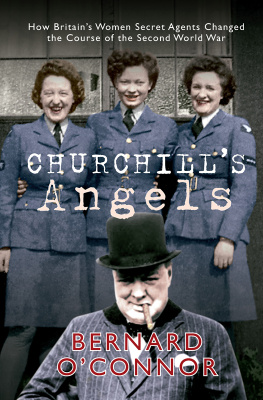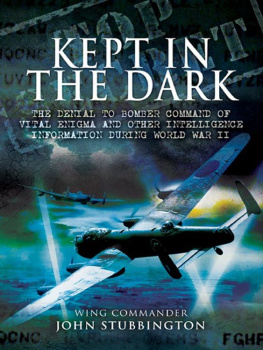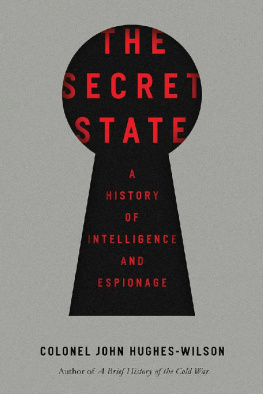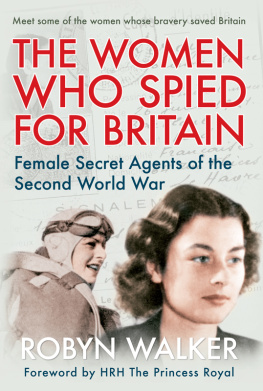
To all those men and women who, in the air, at sea or on the ground, contributed to the Allied victory in the Second World War by obtaining and exploiting air photography.
First and foremost, I must thank all the women and men who have written or recorded their experiences of joining the services and working in photographic intelligence throughout the Second World War. Some wrote for publications, and I thank them or the present copyright holders for permission to quote their words. Others wrote, or dictated, their memories as a record for their families, and here I am grateful to the families of Stella Palmer, Susan Benjamin, Barbara Mottershead, Elspeth Horne and Pat ONeil for bringing them to my attention and allowing me to quote from them. Several writers put their memoirs into national archives, including Joan Zeepraat, Dorothy Colles, Pamela Brisley-Wilson and Mary Harrison, who all deposited their papers at the Imperial War Museum, while the RAF Museum has accounts from Shirley Komrower and Jeanne Sowry.
The Medmenham Collection is the national archive of British photographic interpretation and a major source of much that is contained in the book; this material is reproduced courtesy of the Medmenham Collection, for which I thank the chairman, David Hollin, and the trustees. The archivist and curator, Mike Mockford, his wife Shirley and my husband Chris Halsall, a trustee, have been consistently helpful and encouraging and it is no exaggeration to say that without them I could not have completed the book. I have worked as a volunteer in the collection for ten years, and have compiled biographical notes on many wartime members. When I started the research for the book, the Medmenham Club women members were some of the first to be interviewed. Invariably they gave me informative, and amusing, accounts and provided me with details of other women to contact. I am not forgetting the valuable help that many men have also given me, and I wish to mention in particular Geoffrey Stone, who wrote the foreword with the knowledge of RAF Medmenham and its attitude to women, which could only be expressed by a PI who worked there. I am most grateful to everyone who assisted me in the compilation of all the accounts and memories.
Between 2001 and 2005, Medmenham Club members Sue and David Mander made a number of audio recordings of men and women who worked at RAF Medmenham and overseas during the Second World War. Paul and Harriet Richard, US members of the Medmenham Club, kindly interviewed and recorded Pat ONeil at her home in Maryland in 200910. When the Hughenden Manor staff created a visitors tour and display explaining its important wartime purpose, Peggy Ewert made audio recordings of the men and women who served there. I am grateful to Peggy and the National Trust for agreeing to the inclusion of some of their words in this book. All these valuable recordings, together with the letters and articles regularly contributed by members to the Medmenham Club newsletter since its inauguration in 1946, provide a unique primary source of information on wartime air photographic exploitation.
Many individuals helped by talking, on my behalf, to women whom, through infirmity or distance, I was unable to visit. Marilyn Ward, of the Royal Botanic Gardens, asked questions of Mary Grierson; Jane Crawford of Peggy Hyne; and Lindy Farrell spoke to her aunt, Betty Skappel. Paul Richard put me in touch with George Spear in Ottawa, who recalled Sarah Churchills kindness to his wife, while Sheila Middleton in Australia found details of Jean Starling for me. Steve Lloyd, of the Air Historical Branch, helped me find the other Australian WAAF, Jean Youle, with information on her Military Medal. Grant Thompson provided me with the technical information on Kodak Bromide Foil-Card.
Danesfield House Hotel has assisted in keeping the Medmenham Club in touch with its wartime base by welcoming members and guests to partake of splendid teas in the summertime. Sitting in the rooms where photographs were pored over day after day, or strolling in the gardens to the riverbank to contemplate the same view as the wartime staff, provides a remarkable feeling of being where history was made. The BBC documentary Operation Crossbow revealed the vital role played by RAF Medmenham in wartime and created a great deal of interest.
Members of staff at the Documents Department of the Imperial War Museum, Lambeth Road, were always helpful, as were those at the RAF Museum at Hendon.
I am grateful to Jo de Vries, Paul Baillie-Lane, Christine McMorris and Kerry Green of The History Press for their support and help.
During the past three years I have asked many questions of many people. Everyone has been unfailingly helpful and generous in their time and diligence in answering. Thank you.
Picture Credits
All the air photographs and the ground photographs of RAF Medmenham, including the personnel at work and off duty, Evidence in Camera , the sketches and posters, are held by the Medmenham Collection. All these items are copyright to the Medmenham Collection and reproduced by courtesy of the trustees.
Many women who contributed to the book also provided their own individual and group photographs for inclusion: I am particularly grateful to Millicent Lawton, Jeanne Sowry, Hazel Scott, Pat Muszynski, Elizabeth Hick, Suzie Morgan, Mary Espenhahn, Joan Brachi, Mary Harrison and the families of Diana Cussons, Stella Palmer and Susan Benjamin. The author thanks the copyright holder for permission to use Ursula Powys-Lybbes photograph, and the National Trust for the photograph of the draughtswomen at Hughenden Manor. The photograph of Jean Youle is reproduced courtesy of the Air Historical Branch (RAF), CH 14552 IWM and that of Sarah Churchill at Teheran, CM 005480 by permission of the Imperial War Museum.
The photograph of Pat ONeil was taken by Paul Richard, a US member of the Medmenham Club in 2009, while Margaret Hurley and Xavier Atencio were photographed by Tim Dunn, the producer of Operation Crossbow , for the BBC in 2010.
Danesfield House Hotel provided the colour photograph of the house on a sunny day in 2011. Other photographs are the authors own.
The WAAF watercolour paintings by Mary Harrison are reproduced with her permission and the daughter of Joan Zeepvat allowed the delightful ATS sketches to be used.
C ONTENTS
The Allied Central Interpretation Unit at RAF Medmenham was a remarkable wartime establishment. When I first arrived there, I was at once aware that I was in a very unusual environment, more akin to that of an academic institution than a services unit.
Although the administration was run on orthodox lines, the work of photographic interpretation, which was the purpose of the place, was carried out by an extraordinarily interesting collection of individuals from surprisingly varied peacetime occupations, notably academia, the arts, business and industry. Together with a proportion of army, navy and Allied personnel, many of the interpreters were RAF officers who had been commissioned into the services almost overnight from their civilian occupations, primarily because of their existing skills of acute observation, meticulous attention to minor details, the capacity to make perceptive inferences from small clues, and sometimes to make inspired leaps of imagination. So among them there were archaeologists, geologists and people from the oil industry, many of whom were already experienced in using air photographs, but there were also actors and creative artists.
The outstanding feature of Medmenham, however, that distinguished it from almost all other service establishments, was that a substantial proportion of the highly skilled specialists were women who ranked absolutely equally with their male colleagues, and in some cases were their superiors. These women played a major part in the important contribution that ACIU made to the ultimate victory and this book is a well-deserved tribute to their achievements, little appreciated until now.
Next page
